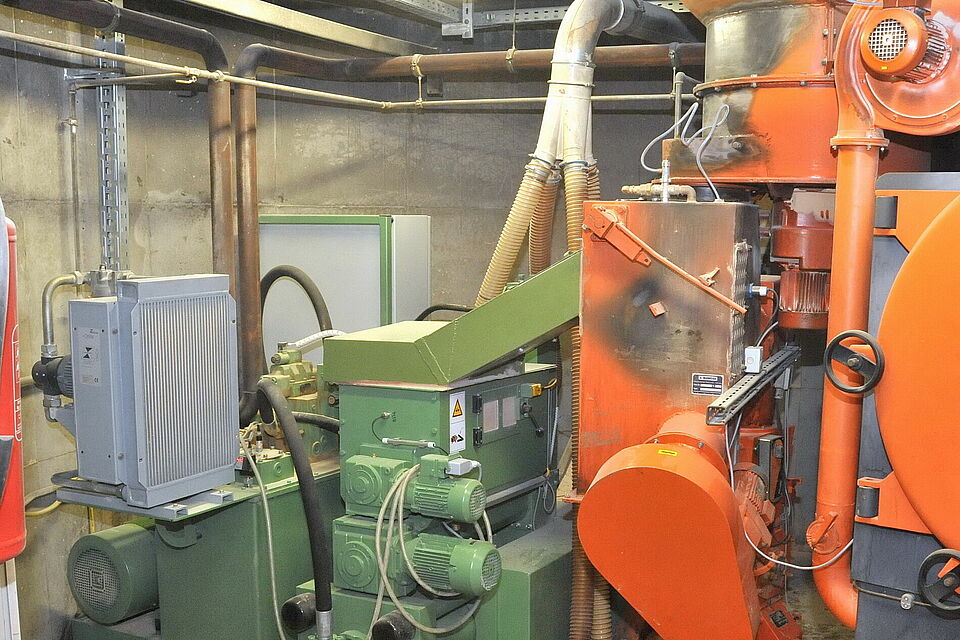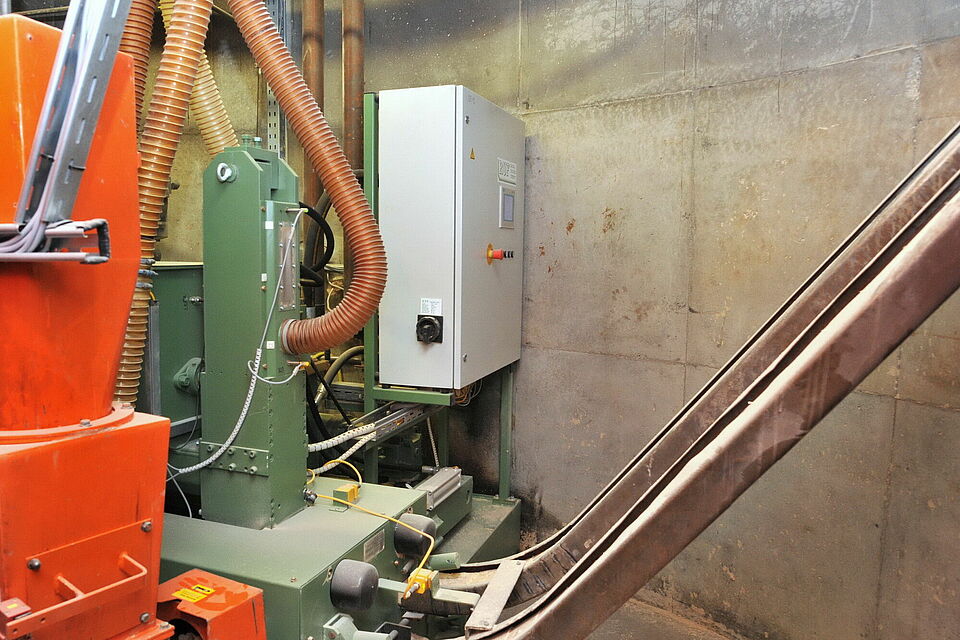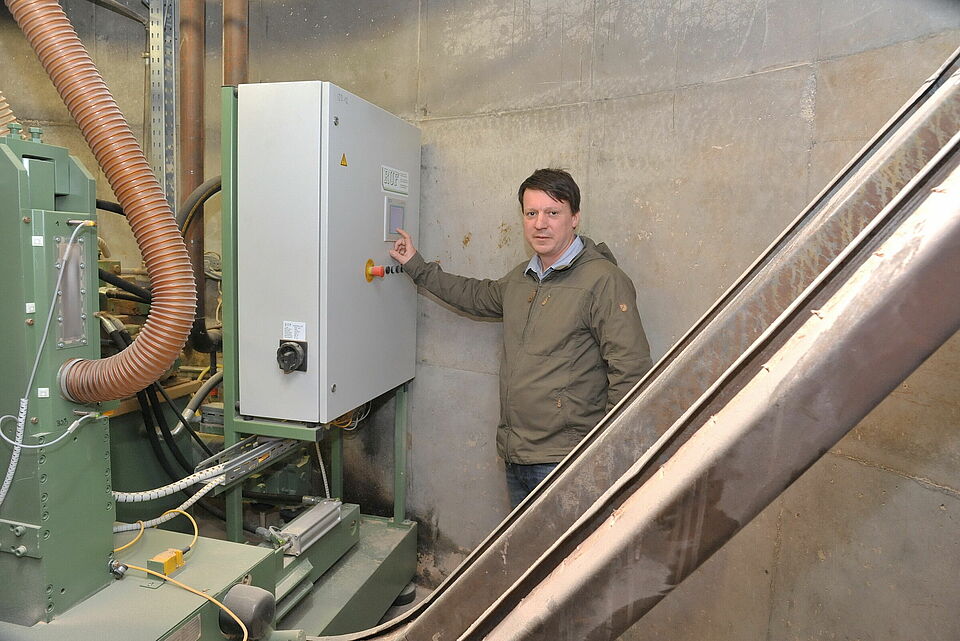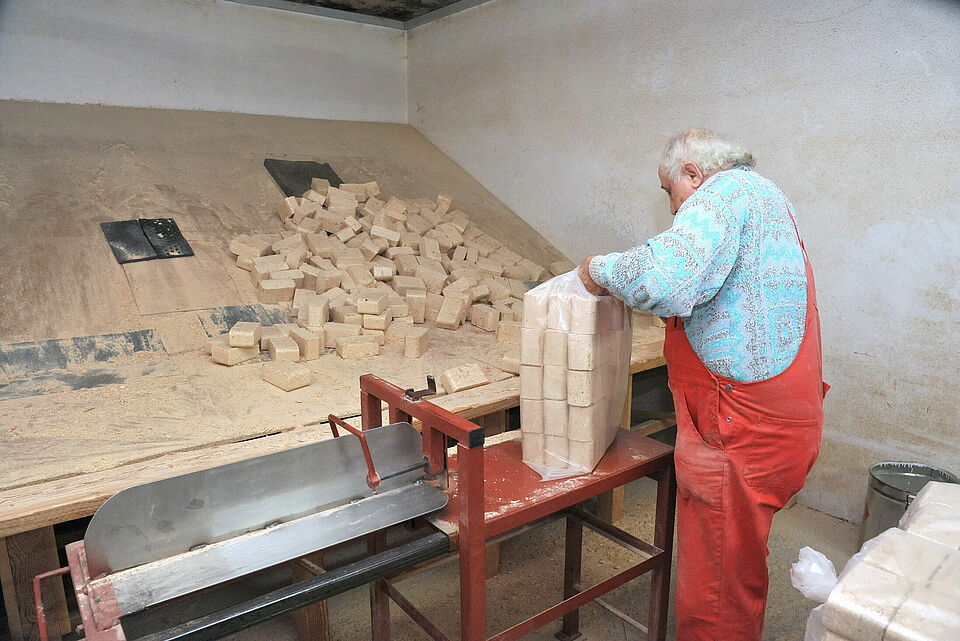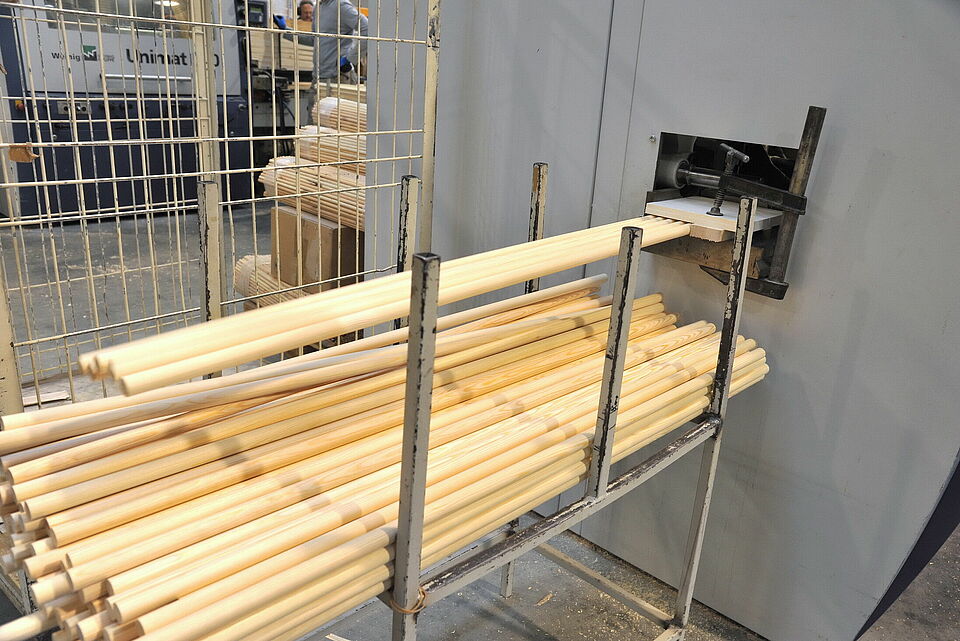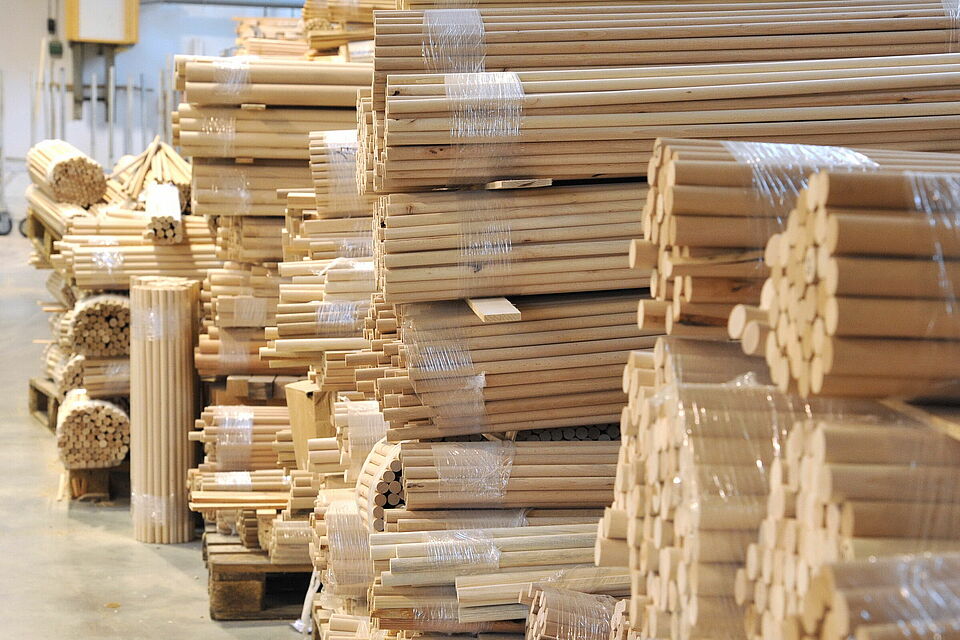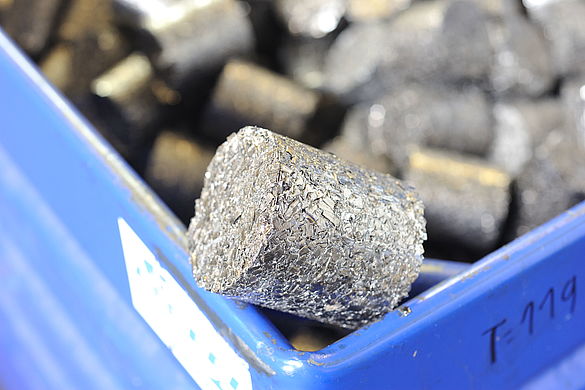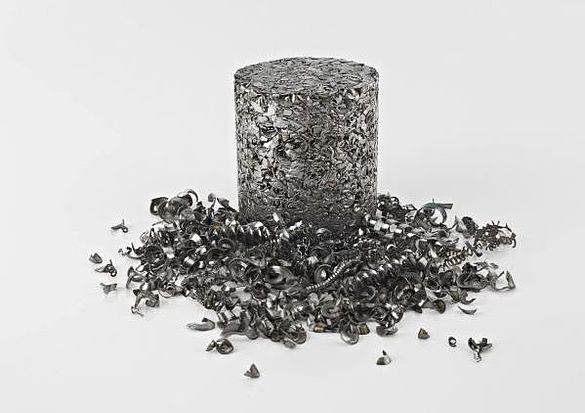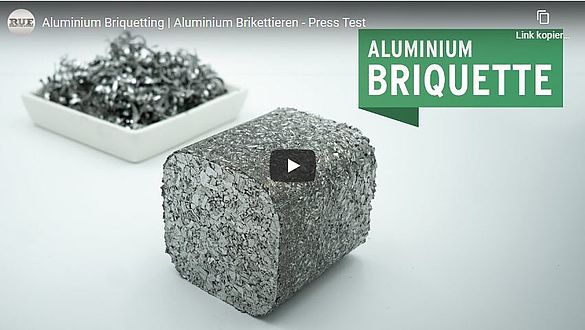The RUF briquetting press earns the Ortinger company additional profits
During the production of round bars or rods for flags, skewers and many more products made from wooden planks, lots of wood chips are accumulated. Instead of disposing of them as waste, the wood processor Ortinger presses them into briquettes, which they then sell as fuel. This way they can economically support themselves in another way and their RUF briquetting press has started to pay itself off from the first day on.
The wood processor Ortinger e. K., which is based in the Bavarian Forest, specialises in round hardwood bars with a diameter of between three and 80 mm. They are used as skewers, Mikado-sticks, for handicraft work as well as flagpoles and banisters. Ortinger furthermore produces rectangular and other profiles and will take over further processing steps such as painting on request.
Even though the Scandinavian countries are home to the wood industry, the Lower Bavarian company has continuously succeeded in exporting to this region. The reasons for this make themselves apparent quickly as Tobias Mayerhofer, who manages the mid-size company in its fourth generation, leads the way through his facilities: Ortinger works flexibly, with high quality and is extremely efficient. But the Mayerhofer family not only convinces with their extensive know-how in wood processing, but it has also proven early on how a win-win situation can be reached concerning ecology and economy. In 1994 the family business invested in its first RUF briquetting press, which produces valuable, CO2 neutral fuel from chips and dust accumulated during production.
The chips had previously been used to fuel a chip heating system. But with increasing production the heating soon was not using up nearly as much material as was accumulated. To dispose of the excess, the silo for chippings was regularly emptied and a service company delivered the material to a chipboard plant. "First we earned a bit of money but in the end we had to pay for it", Tobias Mayerhofer remembers. Also the disposal was always connected with vast amounts of chips and grinding dust flying around.
The Ortinger e.K. company...
… is a family business which produces wood profiles especially round wooden bars and rectangular rails and currently has 35 employees. The wooden profiles are delivered raw, polished, oiled, stained or transparently painted in furniture quality. The products are used for interior construction, in the furniture industry, for trade fair construction, facade construction, in the food and toy industry, as flag equipment and for handicrafts and sometimes sold by DIY stores. The main focus lies on round bars with a diameter of between three and 80 mm, which are automatically produced with round-bar-milling-machines.
Since it was founded almost 100 years ago, Ortinger e.K. has been based in Hinterschmiding, in Bavaria's most eastern rural district, Grafung-Freyenau. About two thirds of its products are sold in Germany. Apart from this, the produce goes to France, the Benelux countries, Poland, the Czech Republic as well as Finland and Norway.
The first press has been running for over 20 years
The RUF 100 briquetting press changed the situation in an instant. Since then, the chips stay in a closed system. Some of the chips are fed from the silo to the heating system. The remaining chips are delivered directly into the briquetting system's hopper. The only thing that's left in the end (apart from the warmth for the facility) is wood briquettes which are then sold off as fuel.
The RUF 100, which was acquired in 1994, is still in use but currently in an Austrian company. Mayerhofer sold the machine in 2011, when it had become too small for his company. "Back then we achieved a strong jump in sales. The chip amounts therefore increased so much, that we needed additional capacity for briquetting", the entrepreneur reports.
After having had positive experiences with the RUF 100, it was clear to Mayerhofer that he would also buy the new machine from the briquetting expert from Zaisertshofen. "We didn't even invite any other offers, particularly as our customers exclusively want RUF briquettes because they appreciate their quality", Mayerhofer emphasises.
Five regional wood processors depend on RUF systems
Mayerhofer has also heard his fellow entrepreneurs in the region praise the RUF systems. "Every wood processor in our vicinity has one or two RUF presses and they are very content with them", the company owner tells us. Including Ortinger, there are five companies in the rural district of Freyung-Grafenau, which own eight RUF briquetting presses between them.
With the RUF 400, which was acquired in 2011, Ortinger produces an annual average of 700 tonnes of wood briquettes from about 5,000 m3 of chips. It was clear from the start that the machine would pay itself off quickly. Based on the amounts, which accumulate at Ortinger and the briquette sales price, an amortisation period of one and a half years was calculated. Market observations showed that in the past years briquette prices of between 130 and 150 euros per ton had been obtained.
The RUF 400 motor powered with 22kW compresses the chips with a specific pressing power of 1700 kg/cm2. The high pressure ensures that the briquettes stay in form without additives. The machine produces briquettes with a cross section of 150x60 mm and an average weight of 830 g.
The heating value is similarly high to that of lignite
The wood briquettes offer the customer a high heating value, because during the pressing process the density increases to about 1 kg/ dm3 and is thus considerably higher than the density of tree trunks. Due to the very dry nature of the wood which the Ortinger company processes (almost exclusively beech), the moisture content is about ten percent or less. This produces a heating value, which with its 5 kWh/kg lies only negligibly under the heating value of lignite briquettes (5.6 kWh/kg). Another advantage of the Ortinger hardwood briquettes is that they emit warmth continuously and consistently because the ember traverses the wood slowly. The briquetting process runs almost fully automatically in Tobias Mayerhofer's company. All of his roughly 30 processing machines are connected to the extraction plant. It transports wood and mill chippings as well as grinding dust into a chippings silo, set up in the outlying area, with a capacity of more than 200 m3. The chip heating and the briquetting system are located under the chippings silo.
Both the collection hopper of the heating system as well as the press are equipped with optical sensors, which register if there are still sufficient chips. If more material is needed, the systems call in more chips from the chippings silo. A system similar to a scraper floor then moves the chips from the silo to the heating and/or the briquetting press.
The heating system is the priority here, so that the warmth supply is ensured. This process still requires manual intervention: Tobias Mayerhofer usually takes a look into the silo in the course of the afternoon. If the chip supply is sufficient for both heating and briquetting he turns on the press. If not, only the heating will be supplied. When production is at its high point, such an amount of chips is created that both the heating as well as the press can operate around the clock. The activation will also be automated soon: A fill level sensor in the silo delivers information as to whether there are sufficient chips for the parallel operation of heating and briquetting.
Briquettes stay in the region and are easy on the environment
In a separate room, the packaging of the finished briquettes into 25 kg-bundles is done completely manually. The two discharge chutes of the briquetting press were extended significantly for its use at Ortinger. They now extend to a building situated higher up, where the finished briquettes fall onto an inclined plane. From there, they slide down to an employee who then wraps 30 of the 800 gram heavy briquettes in foil and piles the bundles onto a pallet.
The customers are mostly local fuel dealers, who supply their regional customers. Local private customers buy smaller amounts. The short transportation routes ensure that the good environmental balance isn't spoiled.


